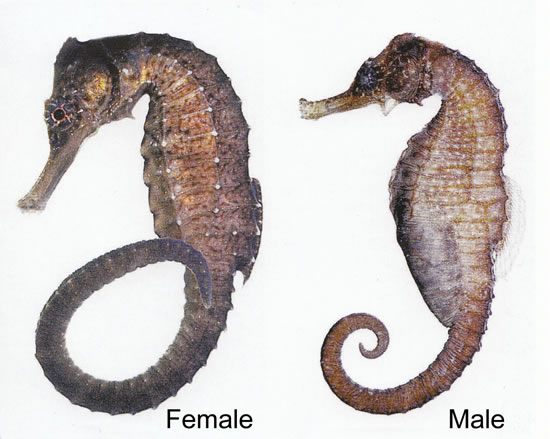Lowcrown Seahorse, Hippocampus dahli Ogilby 1908

A Lowcrown Seahorse, Hippocampus dahli. Source: Rudie Kuiter / Aquatic Photographics. License: All rights reserved
Until recently, the Lowcrown Seahorse, found in north and north-eastern Australia, was thought to be a synonym of the Flatface Seahorse, Hippocampus planifrons, which lives in north Western Australia.
Lowcrown Seahorse, Hippocampus dahli Ogilby 1908
More Info
|
Distribution |
Endemic tropical north and north-eastern Australian species, from Darwin, NT to Moreton Bay, Qld; benthic, in inshore waters on soft bottoms or rubble substrates or in estuarine channels to 21 m. |
|
Features |
Dorsal fin 21-22 (usually 21); Anal fin 4; Pectoral fin 17-18 (usually 17); trunk rings 11; tail rings 37-40 (usually 39); subdorsal rings 4 (2-3 + 1-2). |
|
Size |
Height to about 120 mm. |
|
Colour |
Colour pattern is sexually dimorphic. In life - females mostly pale brown to almost black, usually with small black scribble marks sometimes forming lined, zebra-like patterns; males usually dark brown to almost black with black scribbles. In preservative - similar to live coloration, but somewhat darker. |
|
Feeding |
Carnivores. Like most other seahorses, this species presumably feeds by sucking crustaceans and other small prey items, including planktonic zooplankton, into its mouth. |
|
Biology |
Sexes are separate. The female uses an ovipositor to transfer her eggs into an elaborate enclosed pouch under the abdomen of the male. The male not only fertilizes the eggs inside the pouch and provides physical protection for the developing embryos, he also osmoregulates and aerates the embryos and may provide some nourishment until the offfspring are born. |
|
Fisheries |
Specimens are caught and discarded as bycatch by the prawn trawl fishery. There is no known trade for the Lowcrown Seahorse, however, since the 1960's, the species has declined significantly in parts of Moreton Bay, Qld, possibly due to habitat degradation and commercial trawling. |
|
Conservation |
EPBC Act 1999: Marine Listed under the Federal Environment Protection and Biodiversity Conservation Act 1999 (EPBC Act 1999). http://www.environment.gov.au/epbc/species/marine.html |
|
Remarks |
Until recently, H. dahli was thought to by a synonym of H. planifrons. |
|
Similar Species |
Similar to H. planifrons, from which it differs in having a very low coronet, poorly-developed spines on the trunk and tail ridges, an upward-directed nape spine and in lacking spots laterally on the snout. |
|
Etymology |
From the Greek ippos = horse and kampe = curvature. The specific name dahli is after Knut Dahl a Norwegian naturalist, author of In Savage Australia, published in 1926. |
|
Species Citation |
Hippocampus dahli Ogilby 1908, Ann. Qld Mus. 9(1): 17. Type locality: Noosa, Queensland. |
|
Author |
Dianne J. Bray |
Lowcrown Seahorse, Hippocampus dahli Ogilby 1908
References
Hoese, D.F., D.J. Bray, J.R. Paxton & G.R. Allen. 2006. Fishes, In Beesley, P.L. & A. Wells. (eds.) Zoological catalogue of Australia. Volume 35. ABRS & CSIRO Publishing: Australia, 2178 pp.
Horne, M.L. 2001. A new seahorse species (Syngnathidae: Hippocampus) from the Great Barrier Reef. Rec. Aust. Mus. 53: 243-246.
Johnson, J.W. 1999. Annotated checklist of the fishes of Moreton Bay, Queensland, Australia. Mem. Qld Mus. 43(2): 709-762 [as Hippocampus planifrons]
Kuiter, R.H. 2000. Seahorses, Pipefishes and their Relatives. TMC Publishing, Chorleywood, UK, 240 pp.
Kuiter, R.H. 2001. Revision of the Australian Seahorse of the genusHippocampus (Syngnathiformes: Syngnathidae) with descriptions of nine new species. Records of the Australian Museum 53: 293-340. PDF Open access
Lourie, S.A., A.C.J. Vincent & H.J. Hall. 1999. Seahorses: an identification guide to the world's species and their conservation. Project Seahorse. London UK. 214 pp.
Ogilby, J.D. 1908. New or little known fishes in the Queensland Museum. Ann. Queensl. Mus. 9(1): 1-41.
Pogonoski, J.J., D.A. Pollard & J.R. Paxton. 2002. Conservation Overview and Action Plan for Australian Threatened and Potentially Threatened Marine and Estuarine Fishes. Canberra, Environment Australia, 375 pp.
Whitley, G.P. 1952. Some noteworthy fishes from eastern Australia. Proc. Roy. Soc. N. S. W. 1950/51: 27-32.
Whitley, G.P. & J. Allan. 1958. The sea-horse and its relatives. The Griffin Press, Adelaide, Australia.

